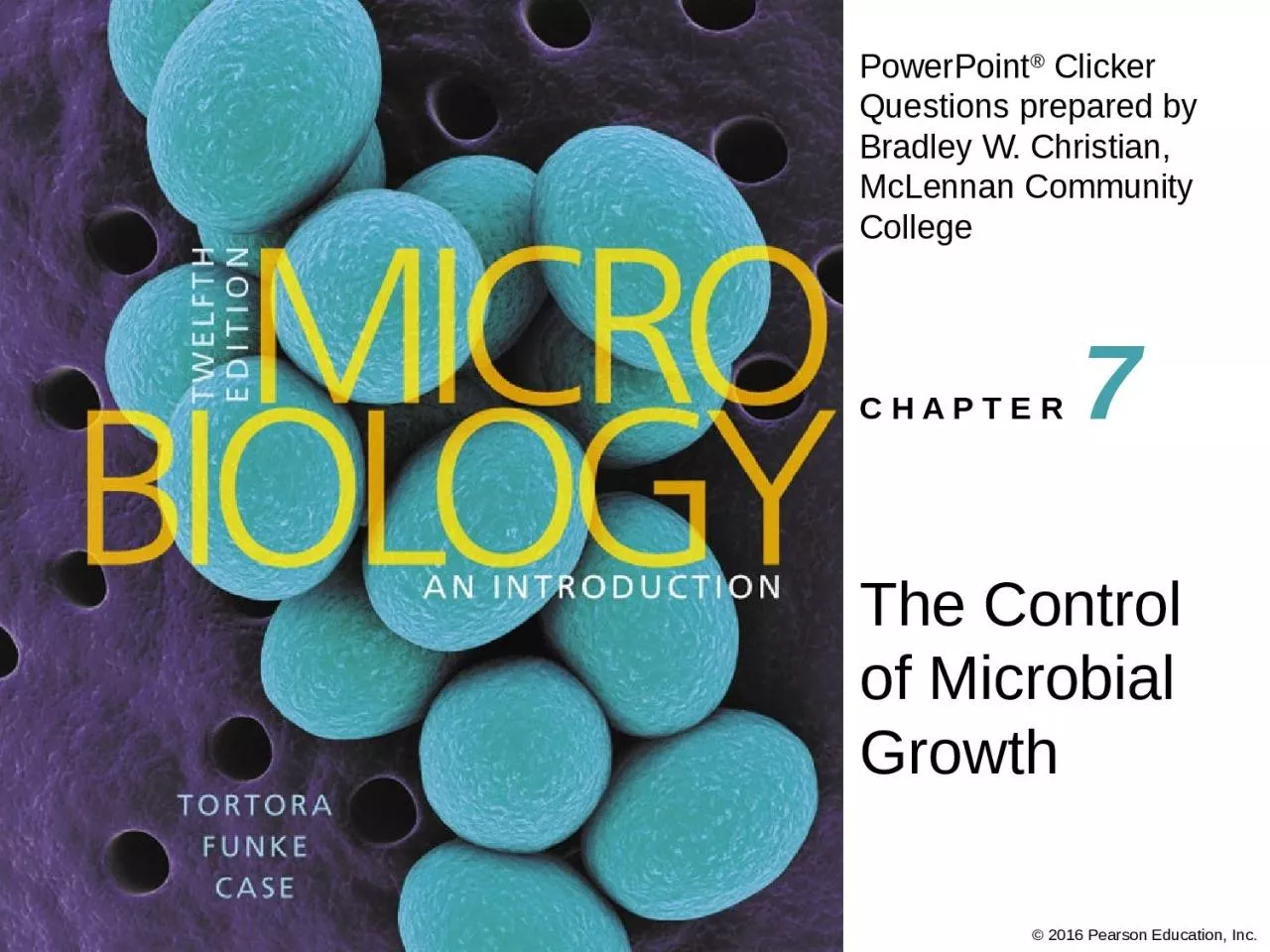

7 The removal or destruction of ALL forms of microbial life is called sterilization disinfection pasteurization sanitization The removal or destruction of ALL forms of microbial life is called ID: 1036672
Download Presentation The PPT/PDF document "The Control of Microbial Growth" is the property of its rightful owner. Permission is granted to download and print the materials on this web site for personal, non-commercial use only, and to display it on your personal computer provided you do not modify the materials and that you retain all copyright notices contained in the materials. By downloading content from our website, you accept the terms of this agreement.
1. The Control of Microbial Growth7
2. The removal or destruction of ALL forms of microbial life is calledsterilization.disinfection.pasteurization.sanitization.
3. The removal or destruction of ALL forms of microbial life is calledsterilization.disinfection.pasteurization.sanitization.
4. The destruction of vegetative pathogens is calledsanitization.sterilization.disinfection.antisepsis.
5. The destruction of vegetative pathogens is calledsanitization.sterilization.disinfection.antisepsis.
6. What treatment is intended to lower microbial counts on eating and drinking utensils to safe public health levels?sanitizationsterilizationpasteurizationantisepsis
7. What treatment is intended to lower microbial counts on eating and drinking utensils to safe public health levels?sanitizationsterilizationpasteurizationantisepsis
8. The absence of significant contamination is referred to assepsis.bacteriostasis.asepsis.biocide.
9. The absence of significant contamination is referred to assepsis.bacteriostasis.asepsis.biocide.
10. Commercial sterilization is a limited heat treatment to destroya) Streptococcus pyogenes.b) Clostridium tetani.c) Staphylococcus aureus.d) Clostridium botulinum endospores.
11. Commercial sterilization is a limited heat treatment to destroya) Streptococcus pyogenes.b) Clostridium tetani.c) Staphylococcus aureus.d) Clostridium botulinum endospores.
12. Which of the following best describes the rate of microbial death when treated with antimicrobial chemicals?Cells in a population die at a constant rate.All cells in a population die at once.Some cells are never killed.The rate varies, depending on the species.
13. Which of the following best describes the rate of microbial death when treated with antimicrobial chemicals?Cells in a population die at a constant rate.All cells in a population die at once.Some cells are never killed.The rate varies, depending on the species.
14. MOST disinfectants work better in ________ solutions.coldwarmacidicorganic
15. MOST disinfectants work better in ________ solutions.coldwarmacidicorganic
16. Damage to which structure causes cellularcontents to leak into the surrounding medium?cell wallplasma membranenucleoidglycocalyx
17. Damage to which structure causes cellularcontents to leak into the surrounding medium?cell wallplasma membranenucleoidglycocalyx
18. In hospitals, the presence of ________ in blood, vomitus, and feces influences the selection of disinfectants.organic matterinorganic matterpathogensodors
19. In hospitals, the presence of ________ in blood, vomitus, and feces influences the selection of disinfectants.organic matterinorganic matterpathogensodors
20. If a population of 100,000 microbes has been treated with antimicrobials for 2 minutes and 90% of the population dies per minute, how many microbes remain after 2 minutes?100,00010,0001000100
21. If a population of 100,000 microbes has been treated with antimicrobials for 2 minutes and 90% of the population dies per minute, how many microbes remain after 2 minutes?100,00010,0001000100
22. To sterilize heat-sensitive solutions such as culture media, enzymes, and vaccines, one should usedry heat.an autoclave.filtration.pasteurization.
23. To sterilize heat-sensitive solutions such as culture media, enzymes, and vaccines, one should usedry heat.an autoclave.filtration.pasteurization.
24. Which method kills microorganisms primarily by the coagulation of proteins (denaturation)?filtrationradiationdesiccationmoist heat
25. Which method kills microorganisms primarily by the coagulation of proteins (denaturation)?filtrationradiationdesiccationmoist heat
26. Heat-resistant bacteria that survive pasteurization are fermented.pathogenic.anaerobic.thermoduric.
27. Heat-resistant bacteria that survive pasteurization are fermented.pathogenic.anaerobic.thermoduric.
28. Direct flaming is one of the simplest methods ofpasteurization.dry heat sterilization.moist heat sterilization.desiccation.
29. Direct flaming is one of the simplest methods ofpasteurization.dry heat sterilization.moist heat sterilization.desiccation.
30. The lowest temperature at which ALL of the microorganisms in a particular liquid suspension will be killed in 10 minutes is called thethermal death point.thermal death time.decimal reduction time.decimal reduction point.
31. The lowest temperature at which ALL of the microorganisms in a particular liquid suspension will be killed in 10 minutes is called thethermal death point.thermal death time.decimal reduction time.decimal reduction point.
32. Which of the following have little value as antiseptics, but are used to mechanically remove microbes?biguanidesquatschlorinessoaps
33. Which of the following have little value as antiseptics, but are used to mechanically remove microbes?biguanidesquatschlorinessoaps
34. Which method of evaluating disinfectants is the currently used standard?use-dilution testuse-diffusion testdisk-dilution testdisk-diffusion test
35. Which method of evaluating disinfectants is the currently used standard?use-dilution testuse-diffusion testdisk-dilution testdisk-diffusion test
36. Which of the following injure(s) plasma membranes and was/were first used by Lister to control surgical infections?halogensozonephenolicsethylene oxide
37. Which of the following injure(s) plasma membranes and was/were first used by Lister to control surgical infections?halogensozonephenolicsethylene oxide
38. The recommended optimum concentration of ethanol to use as a biocide is100%.70%.50%.10%.
39. The recommended optimum concentration of ethanol to use as a biocide is100%.70%.50%.10%.
40. Which of the following is/are NOT used to preserve foods?sulfur dioxidesodium nitritepotassium sorbatebiguanides
41. Which of the following is/are NOT used to preserve foods?sulfur dioxidesodium nitritepotassium sorbatebiguanides
42. Which of the following include the cationic detergents?quatshalogensphenolicsalcohols
43. Which of the following include the cationic detergents?quatshalogensphenolicsalcohols
44. One of the few liquid chemical disinfectants that can be considered a sterilizing agent and is also used for embalming isalcohol.plasma.glutaraldehyde.iodine.
45. One of the few liquid chemical disinfectants that can be considered a sterilizing agent and is also used for embalming isalcohol.plasma.glutaraldehyde.iodine.
46. Peracetic acid is a liquid chemical sporicide that is a type ofperoxygen.biguanide.aldehyde.halogen.
47. Peracetic acid is a liquid chemical sporicide that is a type ofperoxygen.biguanide.aldehyde.halogen.
48. Which agents exert antimicrobial activity via oligodynamic action?aldehydesheavy metalsperoxygensnitrates
49. Which agents exert antimicrobial activity via oligodynamic action?aldehydesheavy metalsperoxygensnitrates
50. What chemical is used to prevent spoilage in wine?sulfur dioxidecalcium propionatesorbic acidsodium nitrate
51. What chemical is used to prevent spoilage in wine?sulfur dioxidecalcium propionatesorbic acidsodium nitrate
52. What chemical selectively inhibits iron-containing enzymes of Clostridium botulinum?sodium benzoatesodium nitratesodium nitritecalcium propionate
53. What chemical selectively inhibits iron-containing enzymes of Clostridium botulinum?sodium benzoatesodium nitratesodium nitritecalcium propionate